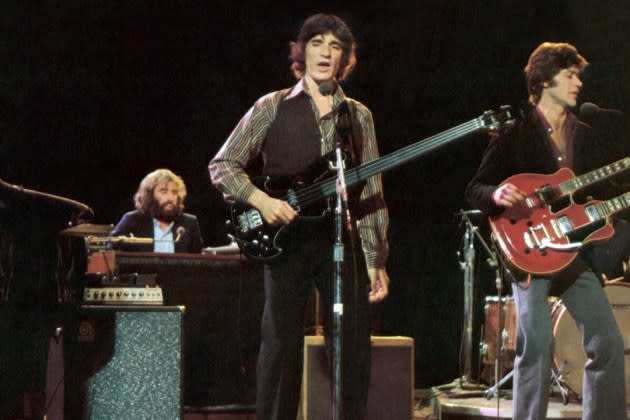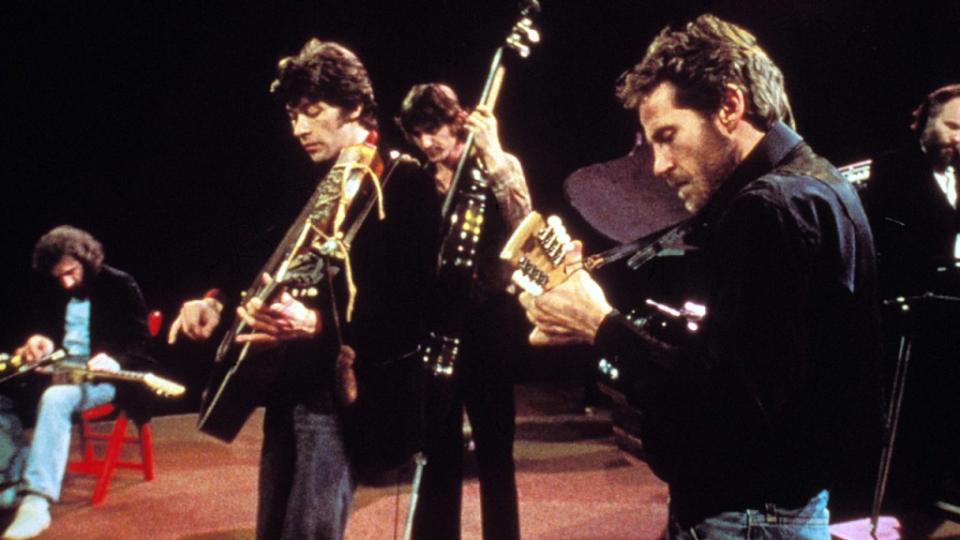Martin Scorsese’s ‘The Last Waltz’ Returns to Theaters for 45th Anniversary, Revisiting One of the Most Famous Concerts in Rock and Roll History
- Oops!Something went wrong.Please try again later.
- Oops!Something went wrong.Please try again later.
- Oops!Something went wrong.Please try again later.
- Oops!Something went wrong.Please try again later.
- Oops!Something went wrong.Please try again later.
- Oops!Something went wrong.Please try again later.
- Oops!Something went wrong.Please try again later.
- Oops!Something went wrong.Please try again later.
- Oops!Something went wrong.Please try again later.
- Oops!Something went wrong.Please try again later.

By the time Martin Scorsese’s music documentary “The Last Waltz” premiered in 1978, the legendary Americana music progenitors the Band, whom the film explores, had gone from “Cahoots” to kaput for two years.
The 1976 farewell concert at the center of the film was already a piece of rock and roll history by the time the film debuted. Seeing it Oct. 5 at the Grammy Museum in Los Angeles in celebration of its 45th anniversary, it’s clear how much history and American music culture was also saying “Good Night” with Rick Danko, Garth Hudson, Richard Manuel, Levon Helm and the Band’s unofficial leader Robbie Robertson (who called the group “the Brotherhood.”)
More from Variety
To help sort out the importance of “Waltz’s” place in rock history were music historian Harvey Kubernik, who shared his recollections of attending the concert at the Winterland Theater in San Francisco; music rights firm CEO/founder Olivier Chastan, who had bonded professionally and personally with Robertson in the last years of his life; and Rhino Records president Mark Pinkus, who helpfully described current efforts to marshal social media marketing to help bring awareness of music from over a half-century ago to the 21st century audience. Veteran music journalist Pamela Chelin moderated the discussion.
Rather than seeming like an artifact, “Last Waltz,” which Chastan announced will return to theaters in an upcoming 800-screen release Nov. 5, plays like a lively, vibrant, spontaneous combustion of feisty yet elegant American musicology. And the music, which is simply astounding, gets a fresh release, per Pinkus, with lots of tunes not in the movie.
The tribal nature of the show is aided by the common love of roots music as performed by the Band and their esteemed guests, which included Bob Dylan, who they famously backed on tour and on one album for Geffen Records; gumbo music great Dr. John; soul gospel stirrers the Staples; Celtic soul poet/belter Van Morrison; English guitar wizard Eric Clapton; and Chicago blues giant Muddy Waters.

If you include Hibbing, Minn., native Dylan, you also note there’s a strong north-of-the-47th-parallel vibe that brings together the four Canadian-born members of the Band — Robertson, Danko, Hudson and Manuel — along with superstar Canadian guests Neil Young and Joni Mitchell and also Southern rockabilly singer Ronnie Hawkins, who spent decades on the Canadian music scene and was the guy who first put the Band together as his backup musicians, then known as the Hawks.
The joyfulness of sharing the stage with fellow artists who changed pop culture forever in the previous 15 years overwhelmed any hints of nostalgia or solemnity. Everyone was too busy proving their songs were the main attraction, a point driven home by Mitchell’s invigorating take on “Coyote” and Young’s punchy, impassioned version of the Crosby, Stills, Nash and Young classic “Helpless.”
Kubernik helped convey the sense of wonder from that night decades ago, when attendees’ expectations for the evening were limited simply to a concert where the Band might be hanging it all up. “You could walk up and buy tickets on the day of the show,” Kubernik recalls, still marveling at how low-key and unexpected it was to become part of one of the greatest nights in rock and roll history.
When Dylan and the Band rip into a propulsive take on blues standard “Baby Let Me Follow You Down,” those with long memories will note that folk-rock really began 12 years earlier when the Animals lifted the song from Dylan’s debut album and released their amped-up version in early 1964.
After lifting “House of the Rising Sun” from the same album, also in 1964, and selling millions of copies, it must have been startling to Dylan, who wasted no time in “Bringing It All Back Home” as his 1965 folk-rock history-making record proclaimed.
In 12 years, from 1964 to 1976, the Beatles arrived and left; Woodstock buoyed a generation’s hopes and Altamont crushed them; Elvis, who inspired the rock revolution, became passe, then hip again, then on his way to an early death; Dylan revolutionized songwriting then crashed his motorcycle and disappeared from live appearance, then re-emerged, backed up by the Band.
Somehow, all of that feels organically processed and captured here, with a nonstop roll of performances that speak to the magic that happened when the blues and country got mixed up, amplifying and transforming into messages of rebellion, passion, joy and eternal existential quests.
Seamlessly breezing from several of the Band’s magnificent greatest hits, such as “Up on Cripple Creek,” “The Shape I’m In,” “It Makes No Difference,” “The Night They Drove Old Dixie Down” and “Ophelia,” to backing Waters on “Mannish Boy,” Dr. John on “Such a Night,” Morrison on a raucous, showstopping “Caravan” and Dylan on closer “I Shall Be Released,” “Waltz” is no musty museum piece. It’s a blast of musical perfection that hits like one of those Canadian blizzards the folkies of the era might have sung about.
And lest one wonder if I’m not dealing in pure nostalgia here, full disclosure: Though I bought the Band’s debut record, “Music From Big Pink,” when it was first released in 1968 and wore it out, along with its epic follow-up, “The Band,” and saw the Band live in 1970 when they toured in support of that album, and I just finished making an Americana music-infused film, which we dedicated to Robert Robertson — until Thursday night, I had never seen “The Last Waltz.”
I can’t explain why that is, but it’s worth noting that this first viewing put to rest any of my fears that too much water had gone under this particular musical bridge or that 1970s fashions, too much period grooviness or Scorsese’s well-known friendship and creative partnership with Robertson might have overwhelmed the substance of the event filmed that night.
I can’t imagine being more stunned in 1978 than I was last Thursday night.
Scorsese’s adoration of Robbie is noticeable throughout the film. Robertson is the author of the songs and he’s also the handsome guitarslinger that the camera loves. For Scorsese to shoot past his greatest visual asset and the genius behind that songbook would have been foolish. His presence never seemed out of place, inappropriate or excessive — quite the opposite.
The whole Band get their moments via performances and interviews. Manuel and Danko, who both died tragically young and tragically addicted, are heartbreakingly vulnerable and unforgettable — both as artists and earnest souls.
Helm’s singing and playing remains one of the great wonders of the rock music world. His attack on the vocals and skins drives the Band to some of their greatest moments, and Marty gets that on film for generations to marvel at.
Hudson, the sole surviving Band member, is a keyboard wizard filmed as a supernatural force.
It’s not the “Robbie and Friends” show. It’s a group portrait for the ages.
Nothing about “The Last Waltz” seems cringey or dated. Still, one might marvel, if you’ve read the accounts of the night, how so much cocaine could be consumed without anyone worrying about dying from fentanyl. Those were the days.
As for the here and now, while so many of the greats on display in “Last Waltz” are gone, Neil, Mavis Staples, Bob, Joni, Van, Eric are all still performing live. May they stay “Forever Young” and may you see them live. May you also see this movie in one of those 800 theaters where it’s about to unspool, and where you must insist, as Scorsese does on a card at the beginning, that the theater managers in 2023 make sure to PLAY THIS MOVIE LOUD.
Purchase tickets to watch “The Last Waltz” in theaters via Fathom Events.
Best of Variety
Sign up for Variety’s Newsletter. For the latest news, follow us on Facebook, Twitter, and Instagram.

